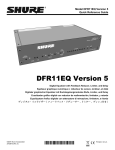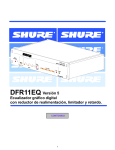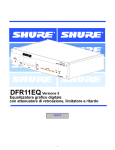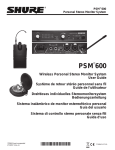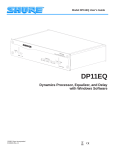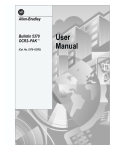Download Shure DFR11EQ Version 5 User guide
Transcript
Shure Incorporated 222 Hartrey Avenue Evanston IL 60202-3696 U.S.A. Model DRS-10 User Guide C S 1 2 1 2 3 HARDWARE ADAPTER SWITCH ASSEMBLY BACK PANEL 10-POSITION SWITCH ASSEMBLY WIRING DIAGRAM FIGURE 1 GENERAL The Shure DRS-10 is a digital switching system that provides remote scene selection when connected to the DFR11EQ version 5. The DRS-10 consists of a hardware adapter, a 10-position switch assembly, and a mounting kit. The DRS-10 provides remote access to all ten scenes that can be stored onboard the DFR11EQ. In addition, the DRS-10 can be customized for use in a three position switch configuration (not included). USING CUSTOM SWITCHES The DRS-10 hardware adapter can be used with a custombuilt switch. Refer to Table 1 for the resistor values needed in the switch to access the desired scenes. TABLE 1 SCENE RESISTOR VALUE 1 97-202 kΩ 2 44-60 kΩ 3 26-32 kΩ 4 17-20 kΩ IMPORTANT OPERATIONAL INFORMATION 5 11.3-13.6 kΩ The DRS-10 works only with the DFR11EQ version 5. The DFR11EQ must be in global scene mode when a switch assembly is used (refer to the DFR11EQ User Guide). No switch assembly can be used to control scene selection simultaneously with the software. The DFR11EQ should be on with the DRS-10 plugged in to execute a scene selection. 6 7.8-9.3 kΩ 7 5.2-6.3 kΩ 8 3.3-4.1 kΩ Multiple switches can be used to control a DFR11EQ when wired in parallel (contact Shure’s Applications Department for details). When using multiple devices for scene control, the most recent scene selected using any device overrides any previous selection. However, if the power is cycled (turned off, then on) the DFR11EQ may not default to the correct scene. CONNECTING THE HARDWARE ADAPTER TO THE 10-POSITION SWITCH ASSEMBLY To connect the hardware adapter to the supplied switch assembly (Figure 1): 1. Determine the distance needed between the mounting area and the DFR11EQ unit. Trim cable to size. 1.9-2.5 kΩ 0.63-1.1 kΩ CUSTOMIZING THE DRS-10 FOR USE IN A 3-POSITION SWITCH CONFIGURATION To connect the hardware adapter to a 3-position switch (not supplied): 1. Determine the distance needed between the mounting area and the DFR11EQ unit. Trim cable to size. NOTE: Cable not supplied. A four-conductor, unshielded cable, such as a Belden 9744, is recommended. The total resistance of the cable run must be less than 100 ohms. 2. Connect a 3-position switch to the hardware adapter as shown in Figure 2. The switch should be wired to provide a separate contact between the C (common) terminal and each of the three numbered terminals. NOTE: Do not use a switch configuration which allows more than one contact-closure at a time. C S NOTE: Cable not supplied. A two-conductor, unshielded cable, such as a Belden 8442, is recommended. The total resistance of the cable run must be less than 100 ohms. 9 10 1 1999, Shure Incorporated 27A8705 (SJ) 3 3. Connect terminal 2 of the switch assembly to terminal S (switch) on the hardware adapter. 2 2. Connect terminal 1 of the switch assembly to terminal C (common) on the hardware adapter using cable. 3-POSITION SWITCH WIRING DIAGRAM FIGURE 2 Printed in U.S.A. CONNECTING THE HARDWARE ADAPTER TO THE DFR11EQ SPECIFICATIONS Connectors DFR11EQ connection: Male 9-pin D sub-connector Cable connection: Screw terminals Case Plastic housing Dimensions Hardware Adapter: 6.3 cm L x 3.3 cm W x 1.6 cm H (2.5 in. L x 1.3 in. W x .65 in. H) Mounting Assembly: 12 cm H x 7.4 cm W x 4.7 cm D (4.75 in. H x 2.94 in. W x 1.87 in. D) Cable Maximum Resistance: 100 ohms series between switch and hardware adapter Maximum Length: at least 914 m (3,000 ft.) Certification Tested to comply with FCC standards. FOR HOME OR OFFICE USE. This product complies with part 15 of the FCC rules. Operation is subject to the following two conditions: (1) this device may not cause harmful interference, and (2) this device must accept any interference received, including interference that may cause undesired operation. Changes or modifications not expressly approved by Shure Incorporated could void your authority to operate this equipment. This equipment has been tested and found to comply with the limits for a class B digital device, pursuant to Part 15 of the FCC rules. These limits are designed to provide reasonable protection against harmful interference in a residential installation. This equipment generates, uses and can radiate radio frequency energy and, if not installed and used in accordance with the instructions, may cause harmful interference to radio communications. However, there is no guarantee that interference will not occur in a particular installation. If this equipment does cause harmful interference to radio or television reception, which can be determined by turning the equipment off and on, the user is encouraged to try to correct the interference by one or more of the following measures: Reorient or relocate the receiving antenna Increase the separation between the equipment and the receiver Connect the equipment into an outlet on a circuit different from that to which the receiver is connected Consult the dealer or an experienced radio/TV technician for help This class B digital apparatus complies with Canadian ICES-003. Conforms to European EMC Directive 89/336/EEC: Professional Audio Products Standard EN 55103 (1996); Part 1 (emissions) and Part 2 (immunity). The DRS-10 is intended for use in environments E1 (residential) and E2 (light industrial) as defined in European EMC standard EN 55103. It meets the applicable tests and performance criteria found in the standard for these environments. EMC conformance is based on the use of recommended cables. Once the switch assembly and hardware adapter are connected, plug the hardware adapter of the DRS-10 into the RS232 port of the DFR11EQ (see Figure 3). DFR11EQ BACK PANEL ÑÑ Ñ Ñ ÑÑ Ñ Ñ ÑÑÑ ÑÑÑÑ ÑÑ HARDWARE ADAPTER CONNECTING THE HARDWARE ADAPTER FIGURE 3 MOUNTING THE DRS-10 SWITCH ASSEMBLY TO A WALL The switching assembly of the DRS-10 may be mounted using the supplied mounting kit (Figure 4): 1. Mount a standard electrical box into the wall. 2. Place the position ring onto the switch assembly, fitting the tab of the ring into the desired numbered groove on the switch assembly. NOTE: The switch assembly of the DRS-10 can be customized to select up to ten scenes. The location of the position ring determines how many scenes the switch is able to access. 3. Peel the plastic sheath from the affixed labels on the wall plate and hardware adapter. A second 10-position label is provided for use on custom wall plates. 4. Insert the switch assembly post through the lock washer and wall plate and attach with the supplied washer and nut, being careful not to over-tighten the nut. 5. Press the supplied knob onto the switch assembly post. 6. Secure the wire cable to the switch assembly using the two screw terminals on the back of the assembly, as previously described in Figure 1. 7. Mount the assembly to the electrical box in the wall. WALL PLATE LABEL SWITCH ASSEMBLY POSITION RING WASHER NUT LOCK WASHER KNOB Replacement Parts Hardware Adapter Kit . . . . . . . . . . . . . . . . . . . . . RPC601 Switch Assembly Kit . . . . . . . . . . . . . . . . . . . . . . RPC603 Wall Plate Kit . . . . . . . . . . . . . . . . . . . . . . . . . . . . RPC602 DRS-10 WALL MOUNTING ASSEMBLY FIGURE 4 2




